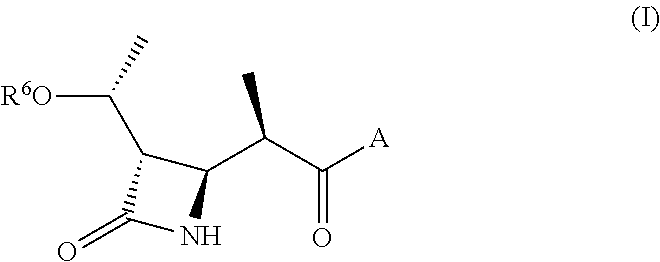Beta lactams as modulators of glutamate uptake and methods for use thereof
a technology of glutamate uptake and beta lactam, which is applied in the direction of drug compositions, organic chemistry, nervous disorders, etc., can solve the problems of affecting the function of the brain, cocaine abuse is often seen as a complicating factor, and affects the brain
- Summary
- Abstract
- Description
- Claims
- Application Information
AI Technical Summary
Benefits of technology
Problems solved by technology
Method used
Image
Examples
example 1
-((R)-1-((tert-butyldimethylsilyl)oxy)ethyl)-4-((R)-1-(4-methyl-1,4-diazepan-1-yl)-1-oxopropan-2-yl)azetidin-2-one
[0565]
[0566]To a solution of (R)-2-((2S,3S)-3-((R)-1-((tert-butyldimethylsilyl)oxy)ethyl)-4-oxoazetidin-2-yl)propanoic acid (0.5 g, 1.66 mmol) in N, N-dimethylformamide (10 ml) was added N,N,N′,N′-tetramethyl-O-(7-azabenzotriazol-1-yl)uronium hexafluorophosphate (0.75 g, 1.99 mmol) and diethylisopropylamine (0.85 g, 6.64 mmol). After stirring at 25° C. for 30 minutes, N-methyl homopiperazine (0.23 g, 1.99 mmol) was added and stirred for 18 hours. The solvent was removed in vacuo. The remaining oil was dissolved in 100 ml ethyl acetate and extracted with saturated aqueous NaHCO3 followed by saturated aqueous NH4Cl. The organic layer was dried with anhydrous sodium sulfate and filtered. The filtrate was concentrated to an oil under reduced pressure. The crude oil was purified by flash chromatography using MeOH / CH2Cl2 as eluent to afford (1, 0.25 g, 38%) as a light yellow s...
example 2
-((R)-1-hydroxyethyl)-4-((R)-1-(4-methyl-1,4-diazepan-1-yl)-1-oxopropan-2-yl)azetidin-2-one
[0567]
[0568]To a solution of (3S,4R)-3-((R)-1-((tert-butyldimethylsilyl)oxy)ethyl)-4-((R)-1-(4-methyl-1,4-diazepan-1-yl)-1-oxopropan-2-yl)azetidin-2-one (0.23 g, 0.58 mmol) in 5 mL tetrahydrofuran at 0° C., 0.5 mL HF / Pyridine (70%) was added and stirred for 10 minutes. The reaction was stirred at room temperature for 18 hours. The reaction was cooled in an ice bath and quenched with concentrated NH4OH and the solution was adjusted to pH 7. The resulting suspension was filtered and the filtrate was purified on a reverse phase 50 g C18 column using H2O / CH3CN as eluent to afford (0.12 g, 73%) as off white solid. 1H NMR (400 MHz, Methanol-d4) δ 4.14 (quin, J=6.4 Hz, 1H), 3.77 (dd, J=1.2 Hz, J=7.4 Hz, 1H), 3.74-3.47 (m, 4H), 3.03 (m, 1H), 2.87 (m, 1H), 2.74 (m, 1H), 2.61 (m, 3H), 2.40 (s, 3H), 2.00 (m, 1H), 1.88 (m, 1H), 1.25 (d, J=6.4 Hz, 3H), 1.22 (d, J=7.0 Hz, 3H). LC / MS M+1=284.4.
example 3
l 5-((R)-2-((2R,3S)-3-((R)-1-hydroxyethyl)-4-oxoazetidin-2-yl)propanoyl)hexahydropyrrolo[3,4-c]pyrrole-2(1H)-carboxylate
[0569]
[0570]The title compound was prepared according to the procedures of examples 1 and 2 except that N-methyl homopiperazine was replaced with tert-butyl hexahydropyrrolo [3,4-c]pyrrole-2(1H)-carboxylate. 1H NMR (400 MHz, Methanol-d4) δ 4.95 (quin, J=6.3 Hz, 1H), 3.84-3.74 (m, 1H), 3.66 (dd, J=1.7 Hz, J=7.7 Hz, 1H), 3.57-3.39 (m, 4H), 3.4 (m, 1H), 3.15 (m, 2H), 2.94 (m, 2H), 2.82 (m, 2H), 1.39 (s, 9H), 1.15 (d, J=6.5 Hz, 3H), 1.22 (dd, J=1.7 Hz, J=6.9 Hz 3H). LC / MS M+23=404.2, M−56=326.
PUM
| Property | Measurement | Unit |
|---|---|---|
| pH | aaaaa | aaaaa |
| pH | aaaaa | aaaaa |
| pH | aaaaa | aaaaa |
Abstract
Description
Claims
Application Information
 Login to View More
Login to View More - R&D
- Intellectual Property
- Life Sciences
- Materials
- Tech Scout
- Unparalleled Data Quality
- Higher Quality Content
- 60% Fewer Hallucinations
Browse by: Latest US Patents, China's latest patents, Technical Efficacy Thesaurus, Application Domain, Technology Topic, Popular Technical Reports.
© 2025 PatSnap. All rights reserved.Legal|Privacy policy|Modern Slavery Act Transparency Statement|Sitemap|About US| Contact US: help@patsnap.com



